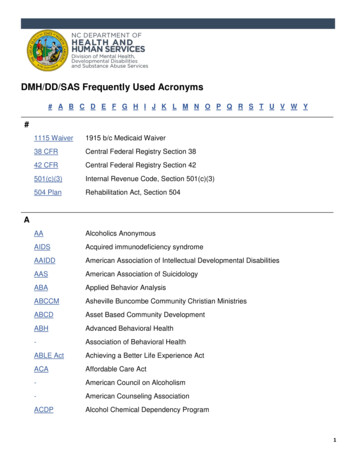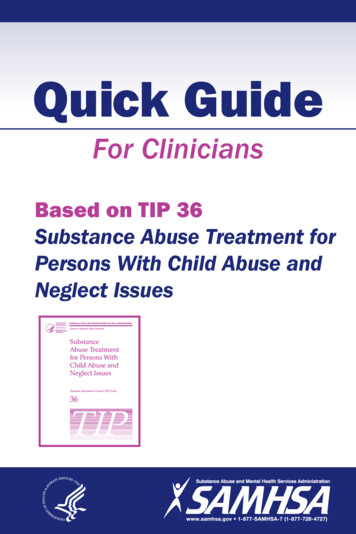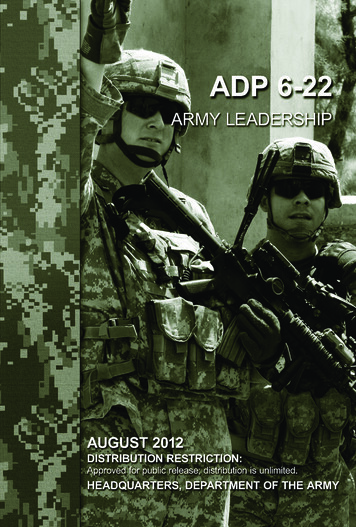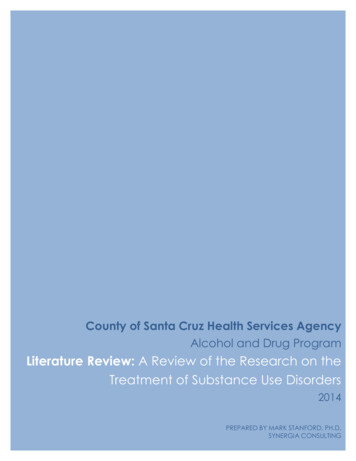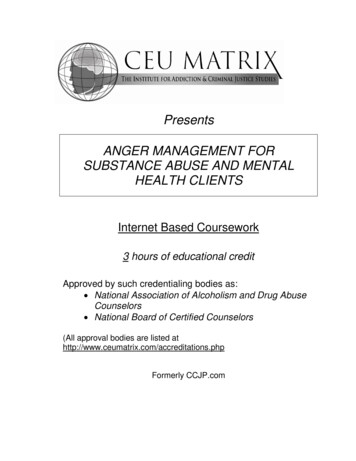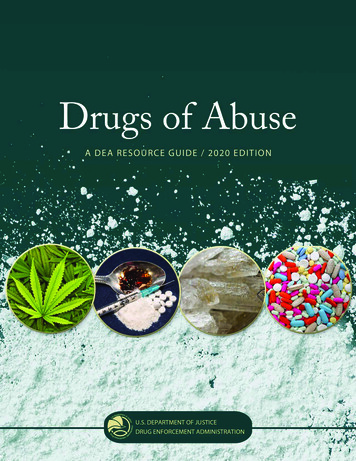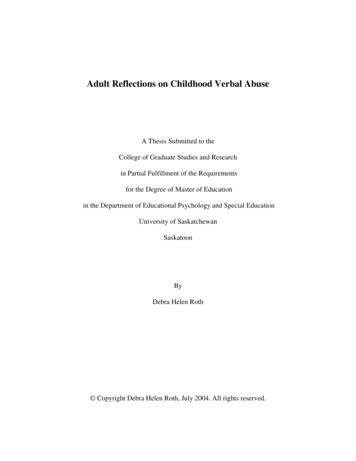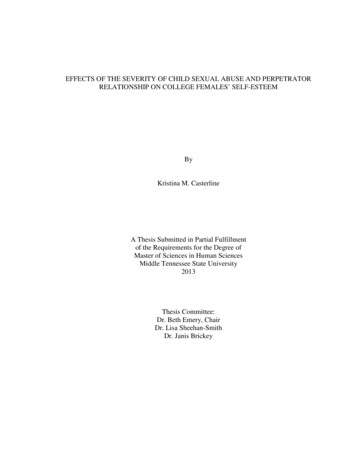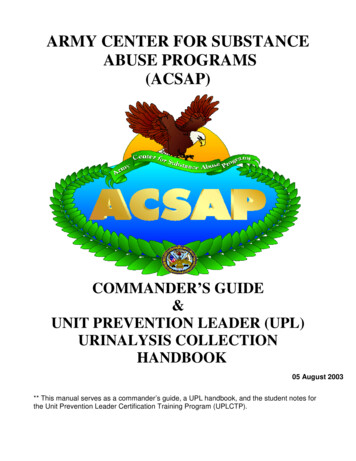
Transcription
ARMY CENTER FOR SUBSTANCEABUSE PROGRAMS(ACSAP)COMMANDER’S GUIDE&UNIT PREVENTION LEADER (UPL)URINALYSIS COLLECTIONHANDBOOK05 August 2003** This manual serves as a commander’s guide, a UPL handbook, and the student notes forthe Unit Prevention Leader Certification Training Program (UPLCTP).
TABLE OF CONTENTSPREFACE . IA. PURPOSE . IB. GENERAL . IC. OBJECTIVE . ID. W ELCOME TO THE UPL CERTIFICATION COURSE . IIE. NEED HELP? . IIF. REFERENCES. IIG. GLOSSARY OF ACRONYMS . IIISECTION I – Commander’s Guide To A Unit Substance Abuse Program . 1A. INTRODUCTION: . 1B. RESPONSIBILITIES: . 1C. RESOURCES. 6SECTION II – UPL HANDBOOK AND UPL CTP STUDENT NOTEBOOK . 1SUMMARY OF CHANGES . 1TRACK I - INTRODUCTION. 31-1: UPL Certification requirements . 31-2: UPL Values . 41-3: Introduction to the ASAP . 71-3-1: The ASAP . 71-3-2: Responsibilities . 8TRACK II – BIOCHEMICAL TESTING I . 132-1: Introduction . 132-1-1: Introduction to Biochemical Testing . 132-1-2: Regulatory Requirements . 13Quota Management . 142-1-3: Types of Testing . 152-2: Bio-safety . 162-2-1. Introduction to Bio-safety . 162-2-2: Wearing and Removing Gloves . 172-2-3: Hand Washing . 182-2-4: Disinfection . 19Immunization for Hepatitis B. 21Hazardous waste . 212 - 3: Biochemical Testing Procedures . 222-3-1: Smart Testing. 22i
TABLE OF CONTENTS2-3-2: Drug Testing Program (DTP) . 262-3-3: Pre-collection Procedures . 301. Date and % of unit to test selection . 302. Schedule test with IBTC . 303. Obtaining supplies . 304. CDR selects personnel to be tested. . 315. Donor notification procedures. 316. Set-up UPL Station . 317. Latrine Inspection . 328. Holding Area. 329. Selection of Observers . 3310. Briefing of Observers . 3311. Commander’s Briefing . 3412. UPL’s Unit Briefing. . 3413. Selected Personnel Will Test. 342-3-4: Collection Procedures . 352-3-5: Post Collection Procedures . 401. Donor Testing: After all specimens have been collected the UPL will: . 402. Temporary Storage of Specimens . 403. Receipt of specimens by IBTC . 424. Packaging the Specimens . 435. Shipment of urine specimens . 452-3-6: Unusual Circumstances . 47Appendix - A: Urinalysis Collection, Packaging And Shipping Supplies . 50Appendix - B: Collection Signs . 52Appendix - C: Observer’s Memorandum . 56Appendix - D: Commander’s Briefing . 58Appendix - E: UPL’s Briefing . 59Appendix - F: Collection Paperwork DD Form 2624 . 60Appendix - G: Collection Paperwork: Unit Urinalysis Ledger. 67Appendix - H: Collection Paperwork: Bottle Label . 71Appendix - I: Making Corrections . 73Appendix - J: Certificate of Correction . 762 - 4: The Laboratory . 822-4-1: Laboratory Procedures . 822-4-2: Detection Times . 852-4-3: Nanogram Levels . 852-4-4: Lab Turn around Time . 862-4-5: Adulterants . 872-4-6: Special Testing . 87TRACK 3: BIOCHEMICAL TESTING 2 . 903 - 1: Receipt Of Results . 903-1-1: Negative Specimens . 903-1-2: Non-Testable Specimens . 90I - ii
TABLE OF CONTENTS3-1-3: The IBTC Dumped the Specimen . 913-1-4: Positive Specimens. 913 - 2: Administration . 953-2-1: Maintaining Files . 953-2-2: Unit Substance Abuse Program Standing Operating Procedure. 983-2-3: Appointment Orders . 99Inspection Program . 102ACSAP Collection Inspection Checklist . 1033- 3: Legal Issues . 1083-3-1: Limited Use Policy . 1083-3-2: Seizure of Urine . 1093-3-3: Other Legal Issues . 1123 - 4: Alcohol Testing. 114General Information on Alcohol . 114Consumption & Metabolism of Alcohol . 1143-4-1: Legal Limits . 1153-4-2: Evidentiary vs Non-Evidentiary . 1163-4-3: Types of Alcohol Tests . 117TRACK 4: PREVENTION . 1194 - 1: Introduction . 1194-1-1: Prevention Definitions . 1194-1-2: Prevention Model . 1194-1-3: Risk Reduction Program . 1204 - 2: Substance Abuse . 1214-2-1: Introduction to Drug Abuse . 1214-2-2: How Substance Abuse Develops . 1214-2-3: How to Refer a Soldier . 1244 - 3: Drug and Alcohol Prevention. 1274-3-1: Campaigns . 1274-3-2: Drugs & Alcohol Free Activities . 1294-3-3: Unit Prevention Plan . 129TRACK 5: TRAINING . 1325 - 1: Introduction . 1325-1-1: Introduction to Training . 1325 - 2: Training your unit . 133A. Training your Unit. 1335 - 3: Drugs and Alcohol . 1365-3-1: Drugs of Abuse . 136iii
TABLE OF CONTENTS5-3-2: Ecstasy and Raves . 145SECTION III– UPL CERTIFICATION TRAINING PROGRAM INFORMATION. 1I. UPL Certification Course Requirements. 1II. Explanation of Terms . 1III. TLOs And ELOs by Track . 2Track 1: INTRODUCTION TO THE ARMY SUBSTANCE ABUSE PROGRAM(ASAP) . 2Track 2: BIOCHEMICAL TESTING 1 . 22-1: Introduction . 22-2: Bio-safety . 42- 3: Biochemical Testing Procedures . 42- 4: The Laboratory . 6Track 3: BIOCHEMICAL TESTING 2 . 73-1: Receipt Of Results . 73- 2: Administration . 83- 3: Legal Issues . 83-4: Alcohol Testing. 9Track 4: PREVENTION . 94-1: Introduction . 94- 2: Substance Abuse . 104- 3: Drug and Alcohol Prevention. 11Track 5: TRAINING . 115-1: Introduction . 115-2: Training your unit . 125-3: Drugs and Alcohol . 12COLLECTION PAPERWORK PRACTICAL EXERCISE . 13DTP PRACTICAL EXERCISES. 21I - iv
05 August 2003Commander’s Guide & UPL HandbookPREFACEA. PurposeThe purpose of this Guide is to assist commanders and Unit Prevention Leaders (UPLs)in developing and implementing a Unit Substance Abuse Program. It serves tostandardize procedures for chain-of-custody collection and submission of urinespecimens to the Forensic Toxicology Drug Testing Laboratory (FTDTL) for testing,provide prevention and training tools and resources for the commander and UPL, andprovide UPLs with a student notebook to assist in their UPL Certification Training. Itdoes not provide any individual with any right or privilege not otherwise afforded by law.This Guide is a ready reference guide for the Alcohol and Drug Control Officer (ADCO),the Unit Commander, and the Unit Prevention Leader (UPL) for the collection, handling,storage, and submission of urine specimens to the FTDTL, and contains preventionresources. Adherence to the procedures and guidelines listed herein will ensure asuccessful commander’s Unit Substance Abuse Program.This guidebook contains three sections: Section I: Commander’s Guide to a Unit Substance Abuse Program – Thissection provides the commander with the Unit Substance Abuse Programrequirements and provides a quick reference to his/her most frequent issues. Section II: UPL Handbook and UPL CTP Student Notebook - This sectionprovides the UPL a valuable resource covering all of his/her duties from urinecollection to prevention training. This section also serves as the notebook for theUPL Certification Training Program CD. Section III: UPL CTP objectives and practical exercises – This section lists theTerminal and Enabling Learning Objectives (TLOs & ELOs) for each block ofinstruction on the UPL CTP CD and contains the practical exercises needed tocomplete the certification course.B. GeneralThe Army is firmly committed to the elimination of substance abuse by its members.Substance abuse within the Armed Forces has been dramatically reduced over theyears as a result of leadership, education, prevention and biochemical testing.C. ObjectiveUrinalysis testing is an important tool available to the commander to assist in preventingsubstance abuse within his/her command. How urinalysis testing is implemented andmanaged within a command is crucial to the success of the program. However,urinalysis testing alone will not eliminate substance abuse within the Armed Forces. Astrong prevention and education training program is crucial to the overall success of ourefforts.I
Commander’s Guide & UPL Handbook05 August 2003D. Welcome to the UPL Certification CourseA. The G1, formally known as the Deputy Chief of Staff for Personnel (DCSPER),and the Director of the Army Center for Substance Abuse Programs (ACSAP) welcomeyou to the Unit Prevention Leader Certification Training Program (UPL CTP).You are about to receive instruction in biochemical testing procedures, instructortraining and prevention/training of alcohol and other illicit drugs. As the Unit PreventionLeader (UPL) you are expected to be the commander’s subject matter expert on allareas within the Army Substance Abuse Program (ASAP), conduct flawless urinalysiscollections, provide alcohol and other illicit drugs training to the unit, and assist thecommander in running his/her drug testing and prevention programs.B. This UPL Certification Training Package (2003) replaces the 2002 with changesto the Drug Testing Program software and replaces MARKS with ARIMS. The 2002version replaced the 1998 UPL Certification Training Program CD-Rom. The CD-Romwas replaced primarily due to the release of AR 600-85, dated 1 Oct 01 which replacedthe 1988 version of the regulation. The summary of regulatory changes is in Section IIof this manual.E. Need Help? If you need more information, have a question or problem with thecourse now or in the future, then follow these steps for help:A. Contact your local garrison Army Substance Abuse Program office.B. Find additional information on the ACSAP website at www.acsap.army.milC. Contact the ACSAP staff for assistance at the following e-mail addressUPL.ACSAP@usadaoa-emh1.army.mil.F. ReferencesA. AR 600-85, Army Substance Abuse Program, dated 1 October 2001B. ACSAP’s SOP for Installation/Community/ASG Collection, Handling, and Shippingof Urine Specimens.C. DOD Directive 1010.1D. DOD Instruction 1010.16II
05 August 2003Commander’s Guide & UPL HandbookG. Glossary of Acronyms6MAM6-monacetyl morphine: The metabolite found in urine forheroin use.ABMDAlcohol Breath Measuring DeviceACSAPArmy Center for Substance Abuse Programs: The DAproponent for drug and alcohol abuse and prevention.ADActive DutyADAPCPArmy Drug and Alcohol Prevention Control Program: Formername of the ASAPADCOAlcohol and Drug Control Officer: In charge of the nonclinical ASAP at the RSC/DRC and Area Command.AFIPArmed Forces Institute of PathologyAOAccident or mishap testAGRActive Guard & ReserveARArmy RegulationARIMSArmy Records Management SystemARNGArmy National GuardASAPArmy Substance Abuse Program: The Army’s program forsubstance abuse and prevention. Each installation andcommand runs an ASAP.AWOLAbsent With Out LeaveBACBlood Alcohol ContentBATBlood Alcohol Test or Breath Alcohol TechnicianBZEBenzoylecgonine: The metabolite found ion urine forcocaine use.CDCCenter for Disease ControlIII
Commander’s Guide & UPL Handbook05 August 2003Glossary of AcronymsCOCompetence for Duty, Fitness for duty or command directtestCOCCocaineCIDCriminal Investigation DivisionCDRCommanderDADepartment of the ArmyDCSPERDeputy Chief of Staff for Personnel: Now known as theArmy G-1, this person is responsible for all personnelfunctions soldier programs within the Army.DoDDepartment of DefenseDoDDDepartment of Defense DirectiveDoDIDepartment of Defense InstructionDTPDrug Testing ProgramDUIDriving Under the InfluenceDWIDriving While IntoxicatedEAPCEmployee Assistance Program Coordinator: Assists civilianemployee with problems to include substance abuse.ELOEnabling Learning ObjectiveEPAEnvironmental Protection AgencyFDFAFederation Drug Free AmericaFTDTLForensic Toxicology Drug Testing Laboratory: The DoDcertified Labs that conduct drug testing.G-1See DCSPERGC/MSGas Chromatography/ Mass SpectroscopyIAWIn Accordance WithIV
05 August 2003Commander’s Guide & UPL HandbookGlossary of AcronymsIBTCInstallation Biochemical Test Coordinator: Runs theBiochemical testing program for an installation.IOMInstitute of MedicineIOInspection Other testIRInspection Random testIUInspection Unit testJAGJudge Advocate GeneralLANLaboratory Accession NumberLCOLaboratory Certifying OfficialLIMSLaboratory Information Management System: The computerdatabase system used at drug laboratories.LSDLysergic Acid enedioxyethamphetamineMDMAEcstasy (3,4-MethyleneDioxyMethAmphetamine)MEPSMilitary Entrance Processing StationMFRMemorandum For RecordmlMilliliter – one thousandth of a liter (1000 ml 1 L)MOMedical directed or physician directed testMPMilitary PoliceMROMedical Review OfficerngNanogramNIDANational Institute on Drug AbuseV
Commander’s Guide & UPL Handbook05 August 2003Glossary of AcronymsOSHAOccupational Safety and Health AdministrationOTSGOffice of The Surgeon GeneralPAPrivacy ActPCPPhencyclidinePEPractical ExercisePMProvost MarshallPOProbable CausePPEPersonal Protective EquipmentPPTPowerPointPTPhysical TrainingRCMRules for Courts MartialRORehabilitation TestRRPRisk Reduction ProgramSAVSite Assistance VisitSJAStaff Judge AdvocateSMESubject Matter ExpertSOPStanding Operating ProcedureSSNSocial Security boxylic acid: Themetabolite of Marijuana in urine that is used to verify druguse.TLOTerminal Learning ObjectiveTOCTable of ContentsVI
05 August 2003Commander’s Guide & UPL HandbookGlossary of AcronymsTOETable of Organization and EquipmentUADCUnit Alcohol and Drug Coordinator: Former name for a UPL.UCMJUniform Code of Military JusticeUPLUnit Prevention LeaderUPL CTPUnit Prevention Leader Certification Training ProgramUPPUnit Prevention PlanUPSUnited Parcel PostURIUnit Risk InventoryUSAMEDCOMUnited States Army Medical CommandUSAPUnit Substance Abuse ProgramUSARUnited States Army ReserveUSPSUnites States Postal ServiceVOVolunteer or consent testVII
Commander’s Guide & UPL Handbook05 August 2003THIS PAGEINTENTIONALLY LEFTBLANKVIII
05 August 2003Commander’s Guide & UPL HandbookSECTION I – Commander’s Guide to a Unit Substance Abuse ProgramA. Introduction:This section of the Commander’s Guide and Unit Prevention Leader (UPL) Handbookwas designed to give commanders a quick reference and the tools needed to run asuccessful Unit Substance Abuse Program.The Vice Chief of Staff of the Army (VCSA) memorandum, titled “Ecstasy Use bySoldiers”, dated 1 Sep 01 states:1. Drug use/abuse adversely affects the Army’s ability to perform its mission and willnot be tolerated. Drug use impacts directly on the safety of the drug user and the othersoldiers within his/her unit. It is every leader’s responsibility to educate soldiers, deterdrug use, and detect illegal drug abusers.2. Commanders must educate their soldiers; fully embrace the tenants of “SmartTesting” by conducting aggressive and unpredictable urinalysis, and take appropriateadministrative and punitive measures against identified drug abusers. In addition,commanders are reminded that they must refer all soldiers with a verified positive drugtest to the Army Substance Abuse Program Clinic for clinical evaluation.B. Responsibilities:AR 600-85 paragraph 1-26 states that commanders will accomplish the following tentasks:Note: Bold print are quotes from AR 600-85, the remaining text provides informationon how to accomplish the task.1. Appoint an officer or noncommissioned officer (E-5 or above) on orders asthe UPL who must be certified through required UPL training addressed inparagraph 2-6h(1) of this regulation. Recommend that a national back-groundcheck be accomplished on all UPL candidates. With information provided throughbackground check, the unit commander will have final decision regarding UPL’seligibility.a. Commanders should select an NCO or officer that has integrity, maturity,attention to detail and maximum retainability to be the UPL. The UPL acts as a unitlevel ASAP by collecting specimens, conducting training, assisting in prevention, andbeing your subject matter expert. Choosing a good NCO/officer will ultimately makeyour job easier!(1) The UPL must be beyond reproach to bribes and looking the other wayduring a urinalysis test.I-1
Commander’s Guide & UPL Handbook05 August 2003(2) The UPL must be able to professionally demonstrate and explain how toproperly collect and directly observe both male and female soldiers.(3) The UPL must be trained and develop his/her technical and tacticalproficiency in the following task (try to maintain your UPLs for at least a year at a time):(a) Design, implement, and evaluate the unit prevention plan, andcoordinate with the installation’s PC to integrate the unit plan into the community’ssubstance abuse prevention plan.(b) Assist in the briefing of all new unit personnel regarding ASAP policiesand services.(c) Administer the unit biochemical-testing program.(d) Inform the commander of the status of the ASAP and of trends inalcohol and other drug abuse in the unit.(e) Maintain liaison with the servicing ASAP counseling center or medicalunit when deployed.(f) Develop, coordinate, and deliver informed prevention education andtraining to the unit.(g) Develop command support for prevention activities by establishing anopen, honest, and trusting relationship with the unit commanders and subordinateleaders.(h) Advise and assist unit leaders on all matters pertaining to ASAP.b. The UPL must complete the ACSAP certified training program CD and localtraining through the local Army Substance Abuse Program.2. Implement a unit biochemical-testing program.You and your UPL must work together to develop a biochemical testing program thatis a real deterrent to drug and alcohol use and/or abuse.a. You must understand the concept of “Smart Testing” and ensure that allsoldiers in your unit believe that they may be tested on any given day at any given time(See page II-22 for additional information on Smart Testing).b. Incorporate alcohol testing as well as drug testing into your program to reducealcohol abuse and support the zero tolerance of underage drinking.I-2
05 August 2003Commander’s Guide & UPL Handbookc. Show command support for the urinalysis program by being present for eachunit urinalysis and giving your briefing.d. Select observers who have the integrity and maturity to perform thisnecessary, but unpleasant duty.e. Ensure that your UPL has access to a computer to utilize:(1) The DoD Drug Testing Program software that randomly selects thesoldiers to be tested and pre-prints all required documentation; This reduces the timenecessary to do a collection, reduces errors that cause a specimen not to be tested,and speeds up the processing time at the testing laboratory.(2) The UPL training CD that is used as a certification program and as avaluable resource tool for the UPL and you.f. Ensure that you support the UPL in conducting forensically soundbiochemical collections.g. Take appropriate actions against soldiers identified as drug or alcoholabusers.3. Implement ASAP prevention and education initiatives addressed inparagraph 2-6 of this regulation. All soldiers will receive a minimum of 4 hours ofalcohol and other drug awareness training per year.a. Work with your UPL and training NCO to schedule 1 hour per quarter of drugand alcohol awareness training. You can even break up the 1hr/QTR into 15 or 30minute blocks of training provided at ranges or down tim
A. Contact your local garrison Army Substance Abuse Program office. B. Find additional information on the ACSAP website at www.acsap.army.mil . C. Contact the ACSAP staff for assistance at the following e-mail address . UPL.ACSAP@usadaoa-emh1.army.mil. F. References . A. AR 600-85, Army Substance Abuse Program, dated 1 October 2001
